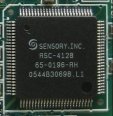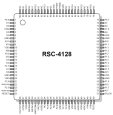


ultimo aggiornamento 25/08/2008

 |
ultimo aggiornamento 25/08/2008 |
 |
|
Il modulo Voice è responsabile della gestione dei riconoscimento vocale,
della riproduzione della voce dei robot e della registrazione e
riproduzione dei messaggi sonori. Il circuito delle dimensioni di 55x32 mm è nella revisione 1.2. E' basato su un microcontrollore RSC-4128 prodotta dalla Sensory specifico per applicazioni vocali e una memoria Flash esterna di 1 MB prodotta dalla Spansion (una società formata da AMD e Fujitsu) modello AM29DL800 la frequenza di clock è dato da un quarzo che riporta la sigla 3,579 JG1 Il modulo Voice, permette di interagire vocalmente con I-Droid 01, attivando o disattivando diverse funzioni. Il riconoscimento di tali comandi, avviene attraverso l'identificazione di parole predefinite, inserite nella memoria della scheda elettronica del modulo Voice. Per rendere comprensibili ad I-Droid 01 le parole pronunciate, è indispensabile parlare in modo naturale, non eccessivamente veloce e senza enfatizzare il tono, ad una distanza, ideale, di circa 60 cm. Naturalmente, la percezione/comprensione delle parole da parte di I-Droid 01, è influenzata dall'ambiente circostante: ambienti in cui ci sono disturbi, eco o riverbero, influenzano negativamente, il riconoscimento dei comandi vocali. Per lo stesso motivo, può capitare che dopo aver attivato la Password, I-Droid 01 non riesca più a riconoscerla e quindi non risponda più ai comandi. |
 |
|
| Scheda lato componenti | Scheda lato rame |

|
|
|
|---|
| Foto del microfono per
riconoscimento vocale (connettore 2) |
|---|
| Foto dell'altoparlante 8 ohm 0,25W
(connettore 3) |
|---|
|
Link al sito dell'azienda che |
 |
|
|
| 1 | 2 | 3 | 4 | 5 |
| Processore | Memoria da 1M | Doppio amplificatore operazionale a bassa potenza | A6 | L21 |
 |
 |
 |
 |
 |
| RSC-4128 | Am29DL800B | LM358 | ||
 |
 |
 |
|
RSC-4128 SPEECH RECOGNITION MICROCONTROLLER |
|
The RSC-4128 represents Sensory’s next generation mixed signal processor for speech and analog I/O. The RSC-4128 is designed to bring advanced speech I/O features to cost sensitive embedded and consumer products. Based on an 8-bit microcontroller, the RSC-4128 integrates speech-optimized digital and analog processing blocks into a single chip solution capable of accurate speech recognition; high quality, low data-rate compressed speech; and advanced music. Products can use one or all features in a single application. The RSC-4128 operates in tandem with Sensory Speech™ 7 firmware, an ultra compact suite of recognition and synthesis technologies. This reduced software footprint enables, for example, products with over 150 seconds of compressed speech, multiple speaker dependent and independent vocabularies, speaker verification, and all application code built into the RSC-4128 as a single chip solution. Revolutionary Text-to-Speaker-Independent (T2SITM) technology allows the creation of SI recognition sets by simply entering text. In addition to improved recognition performance, the RSC-4128 provides further on-chip integration of features.
FEATURES FULL RANGE OF SENSORY SPEECH™ 7 CAPABILITIES
INTEGRATED SINGLE-CHIP SOLUTION
LONG BATTERY LIFE
|
|
|
 |
|||||||||||||||||||||||
|
|
|||||||||||||||||||||||
|---|---|---|---|---|---|---|---|---|---|---|---|---|---|---|---|---|---|---|---|---|---|---|---|
| Elenco revisioni | |
| 25/08/2008 | Inserito foto altoparlante e microfono |
| 09/11/2006 | Aggiornato pagina |
| 28/04/2006 | Emissione preliminare |